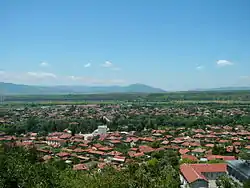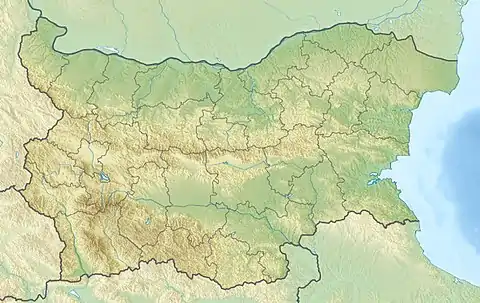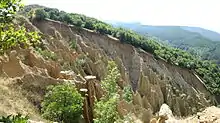Stob (village)
Stob (Bulgarian: Стоб) is a village in southwest Bulgaria, administratively part of Kocherinovo Municipality, Kyustendil Province. Located at the foot of the Rila mountains and not far from the Rila Monastery, Stob was first mentioned in the 7th century and has been in continuous or near-continuous existence since then. Stob is notable for the Stob Earth Pyramids, a natural rock phenomenon in the vicinity of the village.
Stob
Стоб | |
|---|---|
 Overview of Stob | |
 Stob Stob | |
| Coordinates: 42°05′43″N 23°06′16″E | |
| Country | |
| Province (Oblast) | Kyustendil |
| Government | |
| • Mayor | Georgi Stavrev (independent) |
| Population (2013)[1] | |
| • Total | 695 |
| Time zone | UTC+2 (EET) |
| • Summer (DST) | UTC+3 (EEST) |
| Postal Code | 2638 |
| Area code(s) | 07058 |
History and etymology
The village's name first appears in sources in a 7th-century Medieval Greek text as Στοβων (Stovon). It was also mentioned in a charter of Byzantine Emperor Basil II from 1019 after the conquest of the First Bulgarian Empire. The first reference in Old Bulgarian dates to 1378, when it appears in the Rila Charter of Bulgarian Emperor Ivan Shishman as the "town of Stob" (ГРАДЪ СТѠБЪ).[2] The charter emphasizes the Rila Monastery's independence from nearby Stob, among other privileges, and notes that the monastery's lands and properties bordered the town.[3]
A hagiography of Saint John of Rila from the 15th century refers to the village uniquely as Stog (СТОГЬ). However, a chronicle of Serbian monarchs from the 15th–16th century reiterates the name Stob, as does an Ottoman source from 1570. An Ottoman document from 1576 spells the name as Istob and Istub.[2]
The name Stob is thought to derive from the Proto-Indo-European root *sto-bh-:*stei- ("to stand"), as retained in the Bulgarian word стобор stobor ("fence") and akin to words meaning "pole, pillar" in other Slavic languages (cf. Bulgarian стълб stalb). The etymology may reflect the features of the surrounding terrain. The erroneous listing Stog is possibly explained by a false etymology linking the name to the presumably more popular term стог stog ("haystack"), from the related Proto-Indo-European *stogh-.[2]
Geography

The village is located 83 km (52 mi) south-southwest from the capital Sofia and 18 km (11 mi) north of Blagoevgrad,[4] next to the road to the town of Rila and the Rila Monastery. Stob lies between the small towns of Rila and Kocherinovo[5] at the foot of the highest mountains in Bulgaria, the Rila mountains, and is crossed by the Rilska River.[6]
At the northeast end of Stob is the village's Eastern Orthodox church, the Church of Saint Procopius. Stob's church is reportedly the only church in Bulgaria dedicated to this saint.[6] The village's feast day is 17 July.[4]
Stob Earth Pyramids
The Stob Pyramids are a natural rock phenomenon (a set of earth pyramids) located 7 km (4.3 mi) to the northeast of the village. The pyramids have been under state protection since 1964 as a protected site encompassing 74,000 m2 (800,000 sq ft). The pyramids are rock formations up to 12 m (39 ft) high and around 40 m (1,600 in) thick at the base. They vary in shape from sharp through conical to mushroomlike.[6] Some of the columns are topped by flat stones. Groups of individual pyramids have been named the Towers, the Pinnacles and the Samodiva Chimneys.[4]
According to a popular local legend, the pyramids are in fact wedding guests who were petrified[7] because the bride was so beautiful that the best man attempted to kiss her. Based on the legend, the local population has identified some of the pyramids as the best man, the groom, the bride and other attendants of the wedding ceremony.[5]
References
| Wikimedia Commons has media related to Stob. |
| Wikimedia Commons has media related to Stob pyramids. |
- "Stob". Guide Bulgaria. Retrieved 5 July 2018.
- Чолева-Димитрова, Анна М. (2002). Селищни имена от Югозападна България: Изследване. Речник [Settlement names from Southwestern Bulgaria: A Study. A Dictionary] (in Bulgarian). София: Пенсофт. pp. 171–172. ISBN 954-642-168-5. OCLC 57603720.
- Petkov, Kiril (2008). The Voices of Medieval Bulgaria, Seventh-Fifteenth Century: The Records of a Bygone Culture. BRILL. pp. 504-505. ISBN 9789004168312.
- "Стоп в Стоб" [A stop in Stob]. Капитал Light (in Bulgarian). Икономедиа АД. 2008-02-27. Retrieved 14 September 2012.
- Вучков, Веселин Б. (2007-08-17). "Да отидем при Стобските пирамиди" [Let's go to the Stob Pyramids]. Капитал Light (in Bulgarian). Икономедиа АД. Retrieved 14 September 2012.
- Фалин, Кирил. "Вкаменени сватбари на Пирамидите в Стоб" [Petrified wedding guests at the Pyramids in Stob]. Труд (in Bulgarian). Вестникарска Група България ООД. Archived from the original on 22 June 2015. Retrieved 14 September 2012.
- Compare the fate of Phineus and other guests petrified at the wedding of Perseus and Andromeda.
